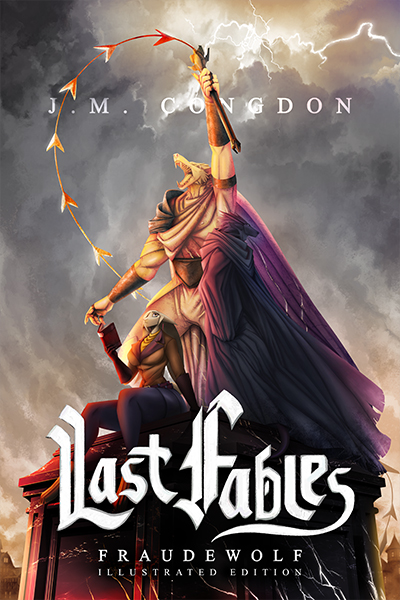Interview with J.M. Congdon
Author of Last Fables: Fraudewolf
Buy this book
How would you describe Last Fables to a new reader?
- Last Fables is a fantasy romance novel set in a world still healing from the scars of a terrible age of monsters that ended a century ago. Magic is powerful and dangerous, but also rare and subtle, something that a denizen can go their entire life without ever spotting a trace of it. The protagonist is an adventuring historian, a scholar who has made the search for a long-vanished hero her life's work.
What was the inspiration behind Last Fables?
- Last Fables all began with a fairly simple question: "What happens at the point where history and myth meet?" The idea was to explore what happens to a hero who straddles both of those worlds, a vulnerable being of flesh and blood with desires and failings who has been immortalized as a legend who makes the ground quake as he passes. My co-creators and I took that basic concept and fleshed out a world around it, trying to create the sort of fantasy book we ourselves wished to read. Something that had the sensibilities of a fable but was grounded with a thoughtful look at the protagonists and how they come together.
Which authors do you admire? How have they influenced your writing style?
- There are a number of authors who have influenced my writing; it's hard for me to narrow it down! I deeply admire the ability Philip K. Dick had to explore unique ideas with sparse and deliberate prose. Frank Herbert's writing has a fascinating philosophical depth to it, and his exploration of how the world someone lives in influences their culture, and vice versa, was a major influence for crafting the setting of Last Fables. I wanted to be sure there was that richness to it, that sense of weight and history that influence everything. While I find H.P. Lovecraft's personal views abhorrent, his ability to find terror in things as mundane as architecture or as major as uncaring god-like beings was a major influence in my sensibility when it comes to the horror aspect inherent to magic.
Can you tell us a little about the locations in your book?
- Last Fables is set on a world called Aerodan, with the story taking place on a vast continent known as the Cradle and more specifically within a nation known as the Circle. The Circle is an alliance of seven powerful city-states surrounded by a protective ring of mountains, and thanks to how it weathered a disastrous age of monsters better than any competing nation it is the cultural capital of the world. A diverse array of mammals and birds call it their home; in a city like Terregor a visitor could see cranes and crows circling the vast buildings, swooping in and out, while otters ply skiffs down the canals and goats hustle along the streets. Although still pre-industrial, the citizens of the Circle take great pride in their ability to craft beautiful works, whether it's their towering university or simply a plate of honeyed pastries.
What advice would you give to aspiring authors?
- There are three major pieces of advice I would give; I can't claim to be an expert but these are the things that have worked for me. First and foremost, find someone to work with. The actual act of writing may often be a solitary process, but there's so much more to it than that. Having a person (or people) that you can bounce ideas off of, that can help you refine and polish your writing, is so helpful. Not every idea you have will be perfect, and having someone to push you to do better will only help the finished book.
Second, planning is key. Personally, at least, I find it extremely helpful to know where a story is going before I write a single word of it. An outline is a useful tool, but it's a map, not a straight jacket. There are many things in Last Fables that weren't planned in advance, and were only included because ideas occurred to me or my co-creators while the book was being drafted. However, because there was a basic framework that we had put together in advance, we could figure out how to make new ideas fit in organically or tweak future bits to make them all work together.
The third is perhaps the simplest but also the most difficult: write. During the drafting of Last Fables, my goal was to complete a chapter every week, which is an average of about twelve pages every seven days. There are certainly authors who can write more quickly than I can, but my goal was consistency. I tried to ensure that I was always producing new pages, because there's a sort of momentum to writing. Having something written makes it easier to write more, and the closer I got to the end the more eager I was to see it finished. Being able to see a story through, from beginning to end, is a wonderful accomplishment, and the only way it's possible if if you write.
What's your writing process?
- The first step, for me, is having an outline. This doesn't have to be anything too fancy; a list of bullet points that breaks down the plot beats works well. When I start writing the story itself, I tend to look for a sort of seed crystal for each chapter. This is just something that I can use as a starting point; it can be anything from a line of dialog to a description of an object to just an evocative idea. Then I build around it; I very frequently write chapters piecemeal and out of order, jumping around as I slowly pull them together. Once I have a chapter, I edit it for flow and to eliminate flaws and errors that I might not have noticed while actively writing, such as repeating a particular word. At this point, I share the drafted chapter with my co-creators and we discuss it, with both of them having the opportunity to critique it and point out any weaknesses they think can be improved or to suggest additions for things I didn't think of. There's usually some back and forth until we're satisfied with the chapter, and then I work on the next one. However, that's not the end of the process; once the book is completed we also go back for another round of editing and tweaking. In Last Fables, for instance, the first chapter went through more than fifteen drafts and some chapters were cut down, combined, or expanded during the final edit.
Which character in Last Fables has had the greatest impact on readers?
- The protagonist is important as the viewpoint that the reader gets into the world and story of a novel, but even knowing that I've been very touched by the reader response to Last Fable's main character, Eni Siverets. Eni is a hare with a seemingly endless well of determination that has kept her going on her quest for years, no matter how many obstacles cross her path. That spirit of hers is a big part of what makes her fun to write and is also what I think readers have connected with. She's an academic but not a recluse, and her continuous zeal to go out into the world and find what she's looking for is very relatable. She struggles and endures, working to make herself the master of her own fate.
If Last Fables were to be adapted for TV or film, who would you see in the lead role? Who did you have in your mind’s eye when you wrote him/her?
- One of the things that made Last Fables an interesting challenge to write is that none of the characters are human. For each and every one of them, there really couldn't be an actor or actress who served as a physical starting point for them. With that being said, we have discussed the voices we thought would fit. In my mind, our protagonist Eni would sound a bit like a young Michelle Yeoh. She has a really lovely feminine warmth to how she speaks.
How have readers responded to Last Fables?
- Last Fables only officially released on July 26th, 2022, so we're still looking forward to hearing more from readers about what they think. However, the feedback that we've gotten from some of our early readers has been very gratifying. Seeing that people enjoy the world and characters that we created, and would eagerly look forward to seeing more of them, has been quite satisfying.
Where next? What are you working on now?
- Last Fables was a wonderful learning experience for my co-creators and me, and we're determined not to let the lessons we learned over our years of work go to waste. We have plenty of ideas for future projects, and we already have some irons in the fire for what comes next.
Synopsis
Over a century ago, a hero single-handedly brought an end to an age of horrors and monsters, and the world has mostly recovered from the devastation since. But the world once again is threatened by darkness. In the realms of carnivores and herbivores, a female jackrabbit has spent ten years in search of a wolf, seeking to be taught what he fears above all else. This illustrated volume includes 44 full color illustrations.

